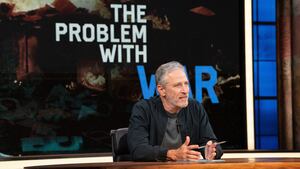The problem with Jon Stewart’s new show, The Problem with Jon Stewart, is not that it’s a cash grab—but its opening credits preempt that notion anyway with a joke.
In a visual brainstorm of the show’s title, we observe increasingly cheeky suggestions like “The Weekly…” “Monthly…” and “Annual…” Words like “program” and “product” intertwine, alongside ideas like The Cash Grab with Jon Stewart. TK OR WHATEVER IT IS. Only six years have passed since Stewart stepped down from his genre-shifting Daily Show run, but it feels much longer. Perhaps that’s why it appears, from his new show’s first two episodes, as though Stewart is still figuring out how he and his new show want to contribute to the new conversation.
Stewart’s final episode on Comedy Central aired just months after David Letterman left his CBS creation, Late Show. That year marked the official change of the late-night guard, as Jimmy Fallon took over The Tonight Show from Jay Leno in 2014 with his former SNL colleague Seth Meyers to follow as his Late Night replacement. Craig Ferguson had stepped down as Late Late Show host in December, and James Corden and Stephen Colbert had already been named his and Letterman’s successors. Also debuting and on the horizon: Last Week Tonight with John Oliver, The Nightly Show with Larry Wilmore, and Full Frontal with Samantha Bee.
It was a big moment, and Letterman and Stewart’s exits, especially, were major productions. (Remember Foo Fighters’ performance of “Everlong” during Letterman’s final episode? I’m getting misty just thinking about it!) But in a twist befitting this era in which nothing is ever really over, Letterman returned to “late night” just a couple years later with My Next Guest Needs No Introduction on Netflix in 2018. It’s little surprise that Stewart would come back as well, but it is a bit of a jolt to see him do so on Apple TV+.
“You don’t even know how to get Apple TV, do you?” Stewart jokes at the end of his Problem premiere. “You don’t even know! It’s just a subscription service; you hit the Apple thing, it says a thing, you click off ‘I agree’—don’t read it! Just say you agree.”
There’s a self-conscious streak to The Problem with Jon Stewart, but Stewart himself doesn’t necessarily seem insecure. In the first two episodes he riffs easily with his audience and, in a nod to his ongoing casual streak during guest appearances on Colbert’s Late Show, sports a navy blue bomber jacket. He seems a little subdued compared to his old self but grows most animated when he addresses veterans’ poor health care—an issue that dovetails with his crusade on behalf of 9/11 first responders. The premiere episode centers on “War” (and how our government happily sends people to fight on our behalf before leaving them out to dry), while the second explores “Freedom.”
Stewart has largely remained off-screen since he parted ways with Comedy Central, working most prominently on first responder advocacy and an extremely charming animal sanctuary in addition to various publicity appearances for projects like his 2020 film Irresistible. (It was the second film he’s directed after his remarkable Rosewater adaptation in 2014.) A production deal with HBO begat plans for a topical animated series that ultimately got scrapped. Sources told The Hollywood Reporter that the premium cabler also wanted The Problem with Jon Stewart but that Apple won out instead.
When you’ve changed political satire for an entire generation and collected 22 Emmy awards in the process, one imagines it eventually becomes clear you have nothing left to prove. Stewart responds to his audience’s silence at the end of a punchline early on in his premiere with unbothered self-deprecation: “I guess that answers whether the show will be funny or not.”
Still, as he settles back into his old job surrounded by former peers who now command their own shows (Oliver, Colbert, Bee) Stewart does have some mojo to regain. Irresistible was smug in all the ways Stewart’s harshest critics say he is—both a comedic disappointment and a political miscalculation. And while Oliver has established a brand of his own apart from Stewart’s, the sentiment that he has assumed the Daily Show host’s old mantle persists.
And then there’s that little cloud hanging over the show’s title. In April, former Daily Show correspondent Wyatt Cenac shared a tweet that said Stewart’s new show is “literally just rebooting” Cenac’s old HBO show, Problem Areas with Wyatt Cenac—which ran for two seasons. Cenac included a clip from his old show in which he says, “If there’s one thing I’ve learned, if you want somebody to take a Black guy saying something meaningful on TV seriously, you really need to have a white guy say basically the same thing right after.”
The beef between Cenac and Stewart goes back to The Daily Show, where Cenac has said the pair’s relationship grew increasingly fraught over the years. In 2015, as Comedy Central braced for Stewart’s exit, Cenac told Marc Maron that Stewart once told him to “fuck off” for saying that Stewart’s Herman Cain impression—which had caught heat from Fox News—reminded him of Tim Moore’s Kingfish character from Amos ‘n’ Andy.

Jon Stewart attends a press conference by members of the U.S. House unveiling the Honoring our Promise to Address Comprehensive Toxics Act of 2021's legislation, dealing with the effects caused by exposure to toxic substances during military service by veterans, outside the U.S. Capitol in Washington, D.C., May 26, 2021.
SAUL LOEB/Saul Loeb/AFP/GettyCenac showed up for the Daily Show correspondents’ reunion during Stewart’s final episode, but it appears he still does not appreciate the apparent similarities between Stewart’s concept and his own. As close as the titles might be, however, the show itself feels distinct.
Stewart does, like Cenac did in his second season, explore one problem from various vantage points per episode. He largely stays relegated to his studio in the first episodes and repeatedly cuts to behind-the-scenes conversations with his writers and producers during each episode.
But he also stages his first on-camera, on-location interview with Veterans Affairs Secretary Denis McDonough—and plays the interview very straight. As Stewart presses the secretary with questions he inevitably evades, peppering in the occasional platitude about how he “doesn’t doubt” McDonough’s empathy, it’s hard to discern why audiences would crave such a thing from him specifically. There are flashes of The Daily Show conviction here, but it will take time—and a few more episodes—for Stewart to define what this next act looks like, and what sets it apart from an increasingly crowded pack.






